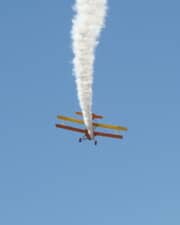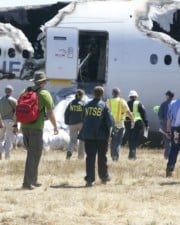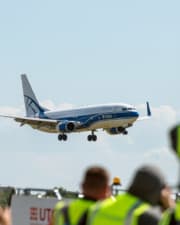If you’ve ever been to an airport, or airfield of any kind, you’ve probably noticed how clean they are. But it’s not that way by accident – there are people whose entire job is to clean up the airfield – and you’ll find it’s like this almost everywhere you go. Indeed, no matter what aircraft fly from any given airfield, it must be spotless. This is to prevent what pilots call “FOD”, but what exactly is it, and why are pilots so scared of it?
In aviation, FOD has two meanings. The first, Foreign Object Debris, refers to any object located on the airfield that’s not meant to be there or isn’t in the right place. The second, Foreign Object Damage, refers to any damage to the aircraft caused by the former.
What is Foreign Object Debris?
Foreign Object Debris means any object that gets near an airplane and does not belong there. Examples include metal parts contaminating runways, having fallen from airplanes, or particles of volcanic ash ingested by aircraft engines, interfering with operation and even causing failure.
Put another way, Foreign Object Debris is anything that has the potential to damage an airplane or injure a person, by being in the wrong place, near the aircraft.
What is Foreign Object Damage?
Foreign Object Damage is damage caused to aircraft by an object that has found its way into a location where such objects should not be. For example, if a metal bolt is ingested by a turbine engine, severe damage to the fan blades and the engine core may result.
What Are The Types of FOD?
There are many types of Foreign Object Debris that can lead to dangerous and expensive issues if not kept under control.
Parts, Tools and Hardware
Years ago, I remember finding a small screwdriver under the hood of my car, left there by a mechanic after a service. It had been there for several hundred miles of driving. Fortunately, the foreign object did not cause any damage or injury on that occasion, but it might have done.
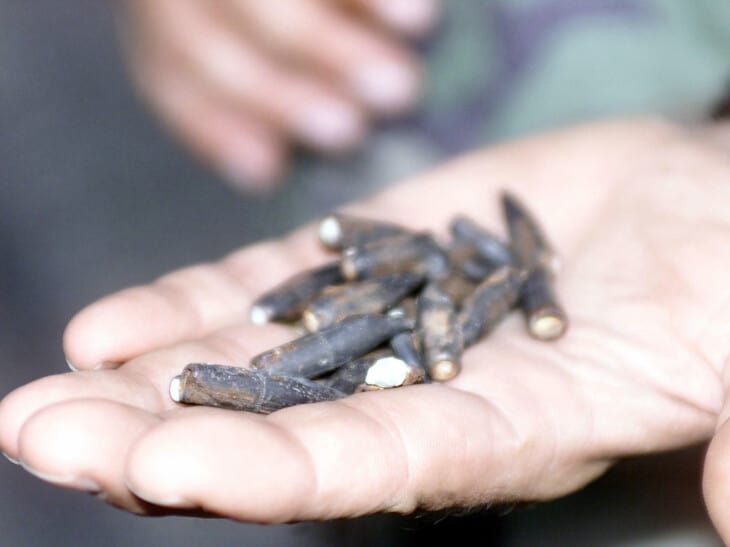
The same thing can happen when airplanes are serviced and undergo maintenance. If spare parts or tools are left about, in the wrong places, they can end up interfering with the safe operation of the aircraft, causing costly damage at least, and possibly endangering passengers and crew.
Building Materials
Airports are constantly developing, with terminals, runways and taxiways being maintained and extended.
Dust, particles of masonry, bits of cinder block and fragments of metal can all be generated when existing structures are removed to make way for improvements. Construction work is known to be messy.
Office and Pocket Sundries
This type of FOD includes, but is not limited to pens, badges, paper, staples, sunglasses, paper clips and coins – the kinds of things that make you fume if they get into your washing machine, possibly tearing your clothes or even damaging or clogging the machine itself.
Such jetsam can find its way into nooks and crannies on the flight deck, obstructing switches and servos, leading to electrical short circuits and possible risk of fire.
Trash, Beverage Cans and Food Wrappers
Litter blowing across airfields can be a source of dangerous FOD. As well as the potential for engine damage, litter contamination can be a threat to tires, leading edges of wings and stabilizers, pitot tubes, windshields and angle-of-attack vanes.
Rocks, Sand and Vegetation
In sandy desert locations, more frequent jet engine inspections are recommended for aircraft taking off and landing at such airfields. Sand particles accelerate wear and tear on turbine blades and bearings.
After a heavy rainstorm, gravel and rocks may have been carried onto airport aprons, taxiways and runways, causing an FOD risk if they are not quickly removed.
Baggage Debris
Busy airports move a large amount of passenger baggage. Items such as tags, straps, metal badges, suitcase wheels, zippers and handles come adrift from time to time and may end up on the ground at the ramp.
If not removed, they may eventually enter parts of airplanes, and cause FOD.
Birds, Wildlife and Animals
We have all heard the remarkable story of Captain Chesley ‘Sully’ Sullenberger, who was forced to ditch his A320 in the Hudson River after losing both engines to bird strikes during the initial climb. All passengers and crew were rescued safely. However, birds are a major hazard to airplanes.
Jet engines can fail immediately if they ingest birds in flight. Airports take routine precautions against bird danger, as we shall see below. Airport staff must also be vigilant for other wildlife, such as wandering bears, or stray dogs and cats.

Insects are another hazard. On occasions, insects have built nests inside the pitot tubes of parked aircraft. If not detected and removed, the insect nests interrupt air flow along the tube, depriving pilots of proper airspeed indication. This can be highly dangerous.
Volcanic Ash
In another well-documented incident, that also has a good ending, a cruising British Airways Boeing 747-200 suffered quadruple (yes, quadruple) engine failure near Jakarta, Indonesia in 1982, after inadvertently flying through a cloud of volcanic ash.
The crew followed correct procedure under very difficult circumstances and eventually landed safely at Jakarta.
It was later found that the volcanic ash – a substance that had not been well understood, until that time – had melted and solidified in the engine cores, and also abraded the fan blades of all four engines.
By persistently following the engine restart procedure during their 15-minute powerless glide, the pilots were able to dislodge much of the contamination and relight the engines, enabling them to make a smooth, safe landing.
Humans
In a few tragic cases, human beings have strayed too near turbine engines that are running, resulting in their being ingested into engines. This can happen because the wind speed around the air intake increases dramatically as you approach the engine.
Therefore, an inexperienced ramp worker might underestimate the danger, unaware that the suction force will intensify hugely in another couple of steps. When they realise their error, it may be too late, and they may find themselves unable to resist the powerful gale.
How is FOD Created?
Most object debris is created by human activities and operations, often when insufficient care is taken to leave no debris behind, and precautions are not taken to detect and remove the debris.
An example of this is the metal strip that fell from an aircraft leaving Paris Charles de Gaulle airport in the year 2000. The strip remained on the runway until a departing Concorde’s main gear ran over it, causing the tire to fail.
Foreign object debris can have natural origins, such as the volcanic ash cloud mentioned earlier. Large hailstones have been known to damage airplanes, necessitating emergency landings.
In October 2022, an A320 made a successful emergency landing in Brazil after hailstones shattered its radome and all but destroyed its windshield.
Hailstones can also cause jet fan blades to fail at high rotation speed. With any engine failure that is not contained by the engine nacelle, engine parts themselves can become FOD, damaging the fuselage, windows, other engines and control surfaces.
How Can You Prevent FOD?
Maintenance Procedures
Aircraft mechanics and engineers need to be meticulous in clearing up after a maintenance job, making sure each tool used is back in its proper storage location, and any unwanted parts are returned to the appropriate parts bin.
Inventories of parts and tools must be kept up to date, so anything missing can be immediately flagged and retrieved from wherever it has been inadvertently left.
Maintenance personnel must also check that all gloves, rags and hats that they have been using are removed from the airplane before the work is signed off as complete. In summary, airplane maintenance hangars should be sterile areas where the location of every tool, spare part and piece of equipment is always known.
The above precautions may increase the time taken for maintenance, which impacts on schedules and incurs lost revenue by keeping airplanes out of service for longer. However, the payoff is enhanced safety, which has to be the highest priority in aviation.
Safe Construction Work
Builders must follow strict procedures to control contamination of areas where aircraft are operating, clearing away any foreign objects and avoiding leaving any debris. Containment of potential foreign object debris must be part of the contract when builders are working at or near active airports.
Additionally, airport runway inspections, and other checks, should be increased in frequency when building work is going on, especially near the site of the construction.
Tidy Flight Deck
Airline flight decks are populated and used by many crews, often with short turnaround times. Flight crews must be careful not to take nonessential items into the cockpit, that could be left behind and become foreign object debris.
Cleaning teams should be vigilant for items that do not belong on board, removing them before the airplane’s next flight.
Use FOD Bins
Airports are littered with garbage bins, known to pilots and airport employees as FOD Bins.
These should be lidded and kept closed, to avoid trash blowing around the airfield. When taking out trash, terminal caterers and others must ensure it all goes into the enclosed bin, and is not left in the open.
Areas where there are dumpsters should be separated from aprons, taxiways and runways by a chain link fence that is high enough to prevent garbage being blown toward aircraft.
Wind barriers, which reduce wind speed and therefore help prevent debris being blown around, are in use at many airports.
Clear Space Around Runways
Vegetation such as trees and bushes near runways and taxiways should be cleared, to avoid the risk of collision or ingestion into engines. Tall trees around the airport should be cut, and monitored frequently for regrowth.
There should never be loose rubble near a runway or taxiway, or any place where aircraft are operating. Runway inspectors should flag any hazard they find, for immediate removal, before the runway can be used for further arrivals or departures.
In sandy locations, dust storms must form part of weather briefings issued to pilots, so they can take the conditions into account and perhaps decide to delay departure until conditions improve, or divert to an alternate airfield if inbound.
Safe Baggage Handling
Meticulous care by baggage handlers is vital if they are to avoid generating potential FOD. Ramps must be inspected carefully once all ground support equipment has been removed, to ensure the paved surface is free from contamination, before the aircraft is moved and engines are started.
Keeping Birds, Wildlife and Animals Away
There must be adequate fencing around the airside part of airports, to keep animals out of zones where aircraft are taxiing, taking off or landing. Security personnel must be trained in removing animals in a timely way, to avoid long, costly shutdowns of parts of the airport.
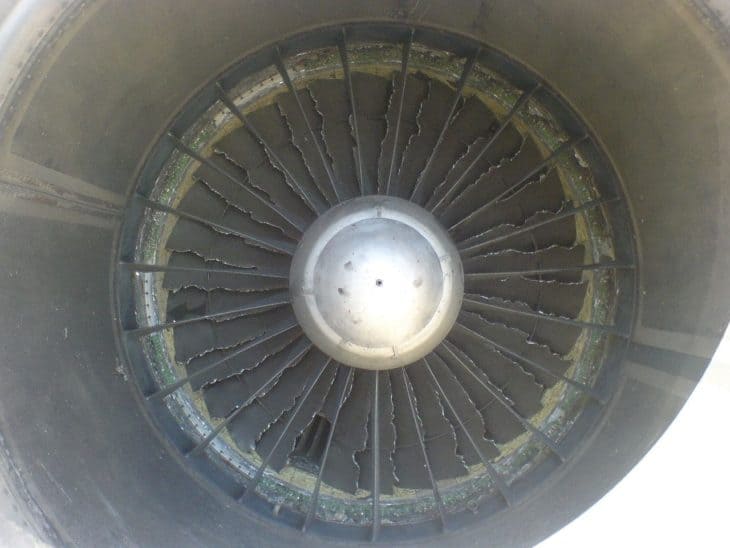
Sonic devices to repel birds are a must at busy airports. Some birds, such as geese and herons, are very heavy and can do serious damage to an airplane if they impact it at speed.
If flocks of birds are detected near airports, arrivals and departures should be suspended for a time, until the bird hazard has been cleared.
If an airplane is to be parked for a long period in a location where insects abound, the pitot tubes must be properly covered, to avoid blockage by insect nests or activity. Prevention of pitot tube obstruction is essential for safe flight.
Volcanic Ash
No-one can prevent a volcano from erupting. That said, we can take precautions to minimize risk to aircraft from volcanic ash.
In 1982, when the 747 mentioned earlier lost engine power after encountering a volcanic cloud, little was known about how ash particles – razor sharp, very hard fragments – could affect airplanes.

These days, pilots and dispatchers are kept well informed about volcanic activity en route, so they can avoid flying through ash clouds.
Every few years, as we see in the news, flights are disrupted or delayed because of volcanic eruptions. At those times, tabloid newspapers are filled with angry reactions of passengers, who have lost days of their holiday or missed business engagements. Safety must come first, though.
Humans
In order to avoid becoming foreign objects, humans must keep away from airport areas where they do not belong.
Obviously, no human should ever be on a runway unless either they have an aircraft’s fuselage wrapped around them, or they are in an authorized ground vehicle (or they are an authorized pedestrian worker).
In all the above cases, every human who ventures onto an active runway must have been cleared by air traffic control to enter that runway for a specific purpose. While the runway is occupied, ATC will of course not allow any aircraft to enter it.
While on the runway, airport workers must maintain a constant lookout. Even though ATC will not clear airplanes to take off or land until the runway is clear, pilots do occasionally make mistakes, such as lining up on the wrong runway.
Also, if an airplane has an emergency situation and no radio, they may have no alternative but to land without ATC clearance. Always keep a lookout, and remember hi-vis clothing is a must.
FOD Plods
A FOD plod is a bit like a low-tech search for clues in a murder mystery – lines of police walk shoulder-to-shoulder across a field, searching for anything the murder suspect may have dropped.
With a FOD plod, very similar lines of airport workers, airline personnel (and sometimes pilots too) in hi-vis jackets scour the runway surface for foreign objects.
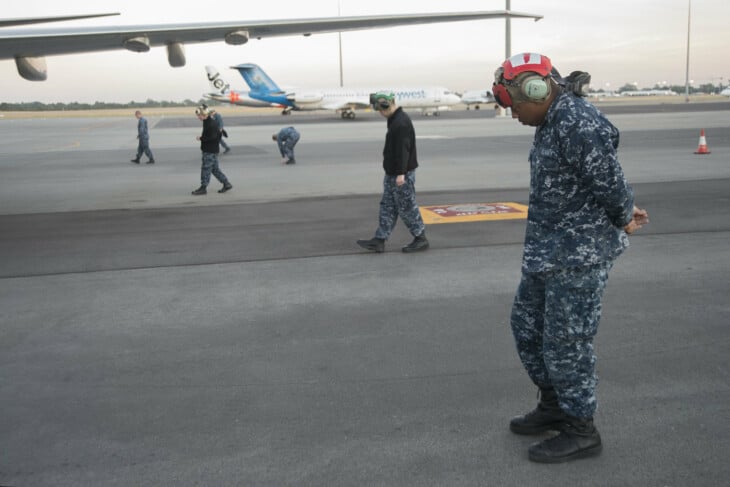
At airports such as LXGB Gibraltar, where a road crosses the runway, the risk of foreign object debris is higher than average, so FOD plods are carried out.
Anyone who finds a foreign object will pick it up and report it. If it can be determined how the object came to be there, precautions can be taken against a recurrence.
Rumble Strips
Airport ground vehicles can sometimes do more harm than good, by inadvertently dropping foreign objects onto runways and taxiways. To prevent this, the vehicles are driven over rumble strips before they enter the airside zone, to dislodge anything that is about to fall off.
FOD Sweeping
Airside areas are swept frequently to remove FOD. This is done partly by vehicles with large brooms attached. Metallic brooms are not generally used, because bristles may become detached and become FOD themselves.
At some airports, magnetic strips attached to vehicles might be used, as they can pick up any ferrous metallic FOD that they pass over. The sort of metallic FOD found most often at airports.
How Often is FOD Training Required?
All personnel who work on the airside of airports should undergo FOD training at least once per year. In many cases, more frequent FOD training is found to be needed. Everyone has a responsibility to be aware of FOD and how they can play their part in eliminating it.
Workers should be screened for the awareness of FOD, and prior training, when they are hired. Part of their job description should be the requirement for regular FOD training.
Who is Responsible For FOD?
Everyone who works at an airport is responsible for minimizing FOD and being aware of how it is produced. All workers should have awareness of the dangers FOD can post to aircraft.
To make this work in practice, airports designate key staff members to be ‘safety focals’. Their role is to develop and implement plans to prevent FOD, and to ensure that any FOD incident is properly logged and reported as per their company’s procedure.
To help all employees discharge their responsibility, a culture of openness must prevail.
That is, if an incident occurs that results in FOD, everyone must be willing to share information that will help prevent the same thing happening again. Employees must understand that future safety is more important than apportioning blame.
For the most effective FOD prevention, employees should be trained using the five S’s, which are as follows.
Sorting
Employees should learn to distinguish which items are necessary to have in the workplace, and which items should not be brought in.
Sweeping
Employees should be trained proper cleaning procedures and techniques, to remove potential FOD.
Standardizing
Employees should all be given the same standard basic instructions, for clarity and consistency.
Simplifying
Instructions should be crystal clear, delivered in accessible language, taking into account that not everyone has English as a first language.
Self-Discipline
Each employee must be aware that they have a share in the collective responsibility to manage and reduce FOD.
How Dangerous is FOD?
Foreign object debris can cause loss of life. In the awful Paris Concorde crash mentioned earlier, the metal strip on the runway was a significant part of what happened.
The strip was certainly not the sole cause of the disaster but, had it not been there for the airplane’s tire to run over, the outcome may have been very different.
The exploding tire caused the left wing fuel tank to rupture, which led to a fierce fire, followed by a rapid sequence of events that led to the crash.
We should never underestimate the potential of even the smallest FOD to cause a serious incident. Even something very tiny, if it’s in the wrong place, can endanger life.
How Much Does FOD Cost?
At the largest airports around the world, there are over fifty million aircraft movements altogether per year. Against that background, around 70,000 FOD incidents take place annually. The total cost of these FOD incidents to airlines is approximately $20 million per airport, every year.
Adding in the further cost of FOD-related flight delays, extra fuel costs, additional aircraft movements and preventative measures boosts the annual cost to some $12 billion.
As we can see, it is in all our interests to reduce FOD incidents, since airlines and airports have to recover that cost, and the flying passenger ends up footing the bill.
Does Foreign Object Damage Reduce an Aircraft’s Value?
A history of damage, however caused, reduces an airplane’s resale value. Damage arising from FOD is of course included in this. FOD is not the biggest factor in deciding an airplane’s value, though.
Provided the damage has been properly fixed, the effect on the plane’s value might not be too worrisome, though will still have a negative impact on the aircraft’s value.
In a list of the factors affecting an airplane’s value, damage history ranks fifth, behind airframe hours and age, engine run hours, equipment installed, and records & airworthiness directives.
Are All Aircraft Susceptible to FOD?
Yes, they are, but to different degrees. Airplanes that fly slowly are at less risk from collisions, with birds or small inanimate objects, than are high-speed aircraft.
Turbine engines are at most risk from foreign objects, because of the high rotation speed of their parts, and because of their sequential design.
Think about it like this. A small rock hurtling toward a single propeller will most likely pass between the blades, provided the rock is moving fast enough, since the proportion of the propeller disk that’s occupied by solid blade is way less than that occupied by empty air.
Throw that same small rock into a jet engine, and it is a certainty that it will hit at least one blade of the N1 fan.
This is because, in the fraction of a second the rock takes to pass the plane of the N1 fan disk, many blades will sweep through the space the rock briefly occupies.
The result will be lots of much smaller rocks, and fragments of fan blade, blasted backward to wreak further havoc inside the engine.
How Do You Identify Foreign Object Damage?
For large-scale foreign object damage, such as that caused by impact with an object of significant size, visual inspection of the aircraft before every flight is the best way to pick it up and ensure the damage does not go undetected.
That is why a walk-around check forms part of every pre-flight, no matter how big or small your aircraft is.
During the walk-around, one pilot visually checks all parts of the fuselage, landing gear and tires, pitot tubes, static ports and angle-of-attack vanes, lights, windshield and other windows, doors, wing leading edges, control surfaces, and propeller blades or jet N1 fans.
When watching a 737 captain perform his walk-around, I saw him spin the N1 compressors of both engines by hand.
I guess he was looking at the blades as they swung slowly past his gaze, alert for any difference of alignment or irregularity which might suggest foreign object ingestion on a previous flight.
Smaller foreign object damage, invisible to the naked eye, is more likely to be detected at a routine maintenance inspection at a dedicated MRO/Part 145 station.
When instruments are used to detect phenomena such as metal fatigue in wing roots, they are also well placed to pick up cracks, holes or abrasions caused by foreign object impact.
During flight, severe foreign object damage becomes instantly apparent to the pilots through their flight instruments.
In the case of Captain Sullenberger’s A320, he and his first officer saw and heard the Canada geese striking the airplane, then immediately noticed both engines running down, despite climb thrust being selected.
Therefore, they correctly deduced that both engines had been rendered unserviceable by bird ingestion, and they set about planning the safest possible unpowered landing, considering a number of nearby airfields before settling on ditching in the Hudson.
Thus, we see the importance of accurate diagnosis of foreign object damage as a key contributor to flight safety. This is equally true if the damage is picked up later during a walk-around or maintenance check.
If the aircraft is deemed not to be airworthy, it will not leave the ground until certified fit to do so after repairs.
Related Posts


